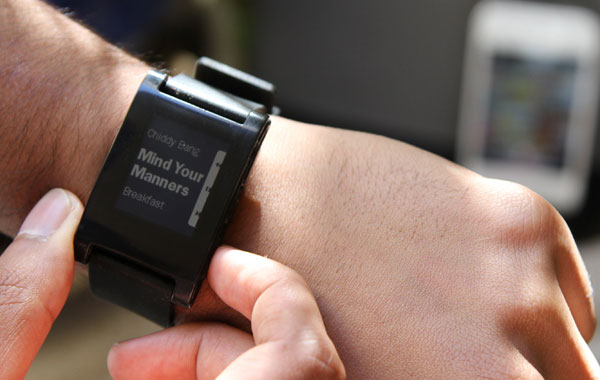Pebble: A Transitional Form of Wearable Computer
Late last year I wondered who would solve “the jetpack problem” for wearable computers: namely, who will present a use case for them that doesn’t presume sci-fi coolness for coolness’s sake? Pebble, the Kickstarter-funded e-ink wristwatch that was finally unveiled at CES this week, is as close to an answer as I’ve seen yet. Why? Because it’s not really a wearable computer at all, and doesn’t try to be.

The truth is, we already have wearable computers in the literal sense: our smartphones, which spend most of their useful lives–and battery lives–riding around concealed in our pockets. The problem that Pebble seeks to solve isn’t “how can I cram all that functionality into something I strap to my arm or face?” Instead, it asks, “how can I create an auxiliary display for that device that doesn’t require me to lug it out of my pocket for simple interactions?”
In other words, Pebble seeks to solve a practical interface problem by being exactly that–an interface. A very simplified one, too. Not a do-everything computer or portal into augmented reality, like Google Glass. And not an expensive bauble that’s only good for one thing, like Fuelband or Fitbit. Pebble is just another, more convenient screen for the device you already wear–your smartphone. Which means it’s as flexible and multipurpose as it needs to be, without trying to reinvent the wheel.
Think about it. Most of the computing functions your smartphone performs would be cumbersome and annoying to use if the whole thing lived on your wrist, Dick Tracy style. (A “wrist phone” never materialized for this very reason, although we certainly have the technology.) But at the same time, a lot of the simpler functions that our smartphones have taken over–like acting as timepieces, or displaying the weather, or nudging us when an important email arrives–don’t really require interacting with the entire computing device. When you feel your phone buzzing in your pocket, you have to pull the whole thing out just to find out what the notification is for. Glancing quickly at a discreet wrist-display seems much LESS cumbersome and annoying in comparison.
This kind of ultra-simple, “glanceable” interaction is where the near future of so-called “wearables” likely lies. A tiny screen hovering in front of your eyeball is certainly glanceable, but it’s not really UN-glanceable either. Whereas a cheap e-ink screen that’s smart enough to connect to the glass brick in your pocket is just “there” enough to make sense when you need it, and not bother you when it doesn’t.
Keep Reading
Most Popular
Large language models can do jaw-dropping things. But nobody knows exactly why.
And that's a problem. Figuring it out is one of the biggest scientific puzzles of our time and a crucial step towards controlling more powerful future models.
The problem with plug-in hybrids? Their drivers.
Plug-in hybrids are often sold as a transition to EVs, but new data from Europe shows we’re still underestimating the emissions they produce.
Google DeepMind’s new generative model makes Super Mario–like games from scratch
Genie learns how to control games by watching hours and hours of video. It could help train next-gen robots too.
How scientists traced a mysterious covid case back to six toilets
When wastewater surveillance turns into a hunt for a single infected individual, the ethics get tricky.
Stay connected
Get the latest updates from
MIT Technology Review
Discover special offers, top stories, upcoming events, and more.